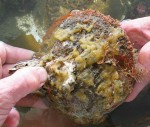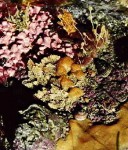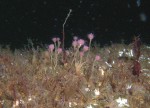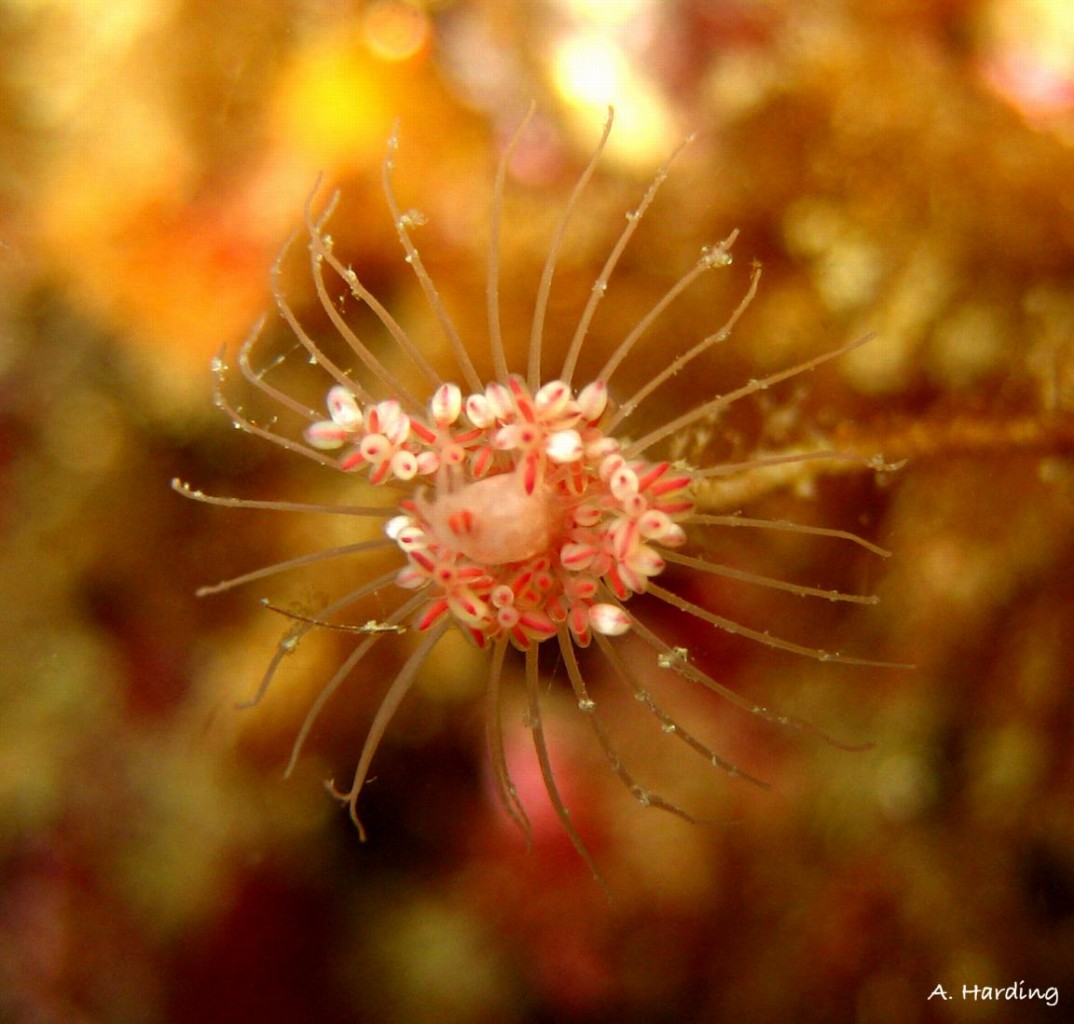-

-
In this picture, the biotic associations of the rock scallop can be seen to consist of several hydroid species. Ectopleura is labelled 1 and 5.
-

-
Ectopleura marina in the upper right hand corner.
-

-
Ectopleura growing out of a sponge (GF photo,1978)
-

-
Ectopleura is an early colonizer on some surfaces of the underwater tidal energy generator .(photo, August, 2007, Chris Blondeau)
The three pictures above of Ectopleura were taken by Ryan Murphy in September 2010.
Physical Description: The Ectopleura marina are in polyp form. Polyps are cylindrical, with one end attached and the other free with tentacles and a mouth for feeding. The polyp stems are usually 2 – 5 cm long, with 18 tentacles in two whorls around the mouth, and 22 – 26 tentacles away from the mouth. Unlike their close relative, Ectopleura marina are solitary, or in groups of well-spaced individuals. Feeding polyps are pink, hence their common name pink-mouth hydroid. Global Distribution: The Ectopleura marina is found on the western coast of North America. Habitat: Ectopleura marina have been found on rocks in low intertidal and subtidal zones where there is fast flowing current. They are fairly common on exposed or semi-protected rocky shores, and are also found on floats. |
| Feeding: When starved for one or two days, polyps will eat active copepods, whereas when well-fed, polyps do not feed or respond to active prey. The polyps catch and stun their prey in their whorl of tentacles. They eat small crustaceans, larvae, chaetognaths, and annelid worms. When developing, polyps feed on eggs of various other invertebrates, plankton, and fish larvae.
Predators: No information on predators has been found, however the tentacles of hydroids contain poisons (nematocysts) that are a good defense against predators.Reproduction: Each colony of hydroids is usually of a single sex, although some hermaphrodites have been found. Medusa buds are produced in clusters which are attached between the two whorls of tentacles on the polyp. These medusoids develop 3 – 5 and do not come free, but rather stay small and attached until gametes develop, and usually die soon after. Sperm is shed into the water, but eggs stay in the medosoids and are not released until they have developed into larvae, which resemble the feeding polyps.
| Domain |
Eukarya |
| Kingdom |
Animalia |
| Phylum |
Cnidaria |
| Class |
Hydrozoa |
| Order |
Hydroida |
| Family |
Tubulariidae |
| Genus |
Ectopleura |
| Species |
marina |
| Common Name: |
pink mouth hydroid |
see this link for other hydroids: https://www.racerocks.ca/tag/hydroid/
Interesting Fact: Ectopleura marina was formerly known as Tubularia marina. It also belongs to one of the most primitive and most diverse groups of multicellular organisms. References: “Hydrozoa.” Wikipedia. Wikipedia Encyclopedia. 12 Nov. 2005 Kozloff, Eugene N. Marine Invertebrates of the Pacific Northewest. Seattle: University of Washington P, 1996. Morris, R H., D P. Abbott, and E C. Haderlie. Intertidal Invertebrates of California. California: Stanford UP, 1980. “Phylum Cnidaria.” BC Marine Life Cnidaria. 13 Nov. 2005 <http://www.elasmodiver.com/BCMarinelife/BCML%20cnidaria.htm>. Strathmann, Megumi F. Reproduction and Development of Marine Invertebrates of North Pacific Coast. Seattle: Washington UP, 1987. |
This file is provided as part of a collaborative effort by the students, volunteers,faculty and staff of Lester B. Pearson College–Grace Ho, 2005
|
|

